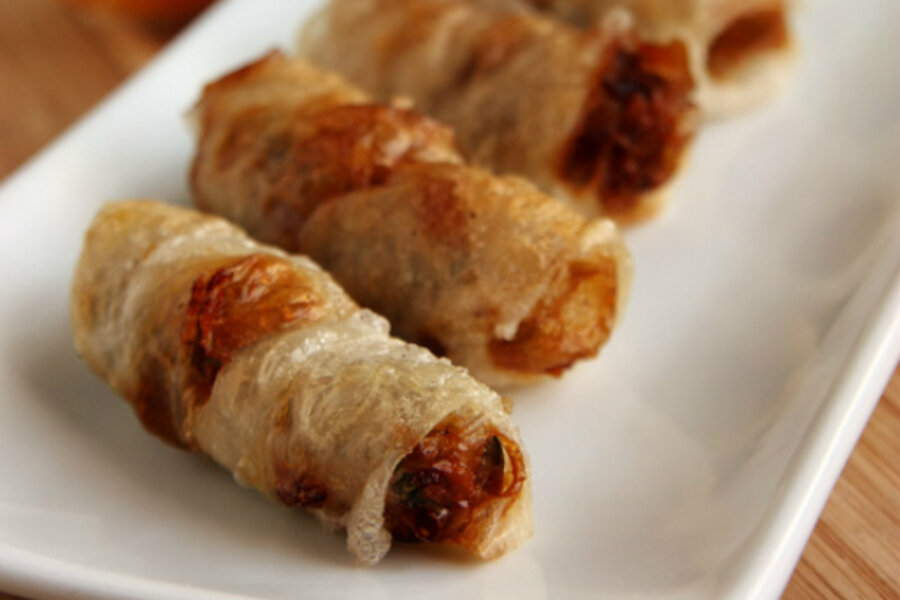Vietnamese egg rolls
Loading...
What recipe would you like to learn if you get one afternoon to learn from a Vietnamese grandmother? For us, and some friends, it was crispy banh xeo and Vietnamese egg rolls, called chả giò in the south and nem rán in the north. Since we blogged about banh xeo already, we’ll concentrate on the venerable egg roll.
How are Vietnamese egg rolls different, than say, Chinese egg rolls? Vietnamese egg rolls are typically wrapped with a rice paper whereas Chinese egg rolls are wrapped a wheat base wrapper. They both contain a variety of chopped vegetables and can be made with pork, shrimp, or leaner meats such as chicken or turkey. The textural differences between rice paper and wheat paper is stunning. The rice paper roll is both crispy, bubbly and pleasantly chewy, a great alternative to the wheat based wrapper. Hong’s parents have been making Vietnamese egg rolls for over 20 years in addition to banh cam at their church, raising money for parish activities.
So for one afternoon we were all eager sponges, soaking up tips learned from over 40 years of cooking from Hong’s mom, a mother of four and grandmother of two and soon to be three, making banh xeo and chả giò. We’ve previously posted the banh xeo recipe so we won’t comment too much on that here, except to use a good nonstick pan and go low and slow on the heat for crispy banh xeo. But in case you’re wondering, the banh xeo made by all the learners came out delicious!
So now that we’ve tantalized you with banh xeo, let’s get serious about making chả giò. Its harder to find Vietnamese egg rolls made from rice paper these days. The convenience of the wheat wrapper along with even golden brown color makes it an easy alternative. The main reason is that rice paper is a little tricky to fry and doesn’t get beautifully golden brown like the wheat based egg roll wrappers. When the rice paper hits the hot oil, it immediately bubbles up and blisters. If two egg rolls touch, they will stick to one another. The blistering does calm down after a few seconds, however allowing you to fry as normal.
The filling can be any variety or combination of meats described above. Personally we love pork and shrimp together, but any will do. We always use wood ear mushrooms and bean thread noodles but vary other vegetables depending on what we have on hand or convenient at the market. For vegetables we prefer any combination of shredded jicama, taro, or carrots. Bean sprouts are another alternative. Vietnamese egg rolls typically do not contain cabbage.
Wrapping an egg roll isn’t terribly complex. However, we didn’t realize some of the reasons why we roll the way we do. Hong’s mom said it’s not just to keep the filling inside, but to also have even layers of wrapper around the filling so it will cook evenly and brown evenly. This is most evident at the ends of the egg rolls, when not wrapped carefully, tends to have only 1 or 2 layers of wrapper so it will cook faster and turns dark or burns while the rest of the egg roll is nice and golden.
To avoid this, place your filling on one end of your wrapper paper. Press down each end to form first layer. Crease the bottom, then fold the double layer of wrapper back up, forming 3 layers of paper covering the ends. Use this method whether you’re using rice paper or wheat paper. Another trick we learned is that Mom doesn’t use an egg wash to seal the egg rolls. The egg causes a discoloration at the seal and it dirties the cooking oil. Instead, she makes a simple tapioca starch slurry, cooked to a viscous paste that works like a charm.
Enjoy Vietnamese egg rolls with noodles such as bun thit nuong or simply on it’s own, wrapped with lettuce and Vietnamese herbs such as perilla, balm, mint or basil dipped with some nuoc mam cham and do chua.
We all had a great time eating, learning, and laughing together. Thank you so much Mom!
Vietnamese egg rolls
Yield: about 40-50 egg rolls
2 lbs. ground pork
2 medium jicama, shredded
1 small taro root, shredded
2 medium onions, coarsely chopped
1/2 cup wood ear mushroom, soaked
1 cup bean thread noodle, soaked and cut
2 teaspoons salt
2 teaspoons ground pepper
2 teaspoons sugar
2 package (25 pieces) spring roll shells (wei-chuan brand) or packages of rice paper
Tapioca slurry:
2 tablespoons tapioca flour
2 tablespoons water
Mix all ingredients together in a large mixing bowl. Test flavoring to your tastes by microwaving a small tablespoon for about 30 seconds and adjust seasoning to your taste. Any vegetable such as jicama and taro can be substituted (or omitted) for carrots or bean sprouts. Any type of ground meat can be substituted combined such as chicken or turkey or pork and shrimp.
Mix the water and tapioca in small sauce pan on low heat and cook until it thickens to paste and turn of heat and set aside.
Place about 2 tablespoons of filling onto the edge of your wrapper and make one half roll. Crease the ends as shown above, and then fold up the sides. Complete the roll and seal with small amount of tapioca slurry.
Fry in small batches at 350 degrees F. until golden brown. Place on cooling rack.
Note: Rice paper will never brown as nice as wheat based paper. If using rice paper, fry only a few at a time, do not let them touch or touch them for the first minute.
For a pictorial guide on rolling the egg rolls visit The Ravenous Couple blog here.





